IT subsystems of the sports center: pre-reality, security, medicine, point accounting, etc.
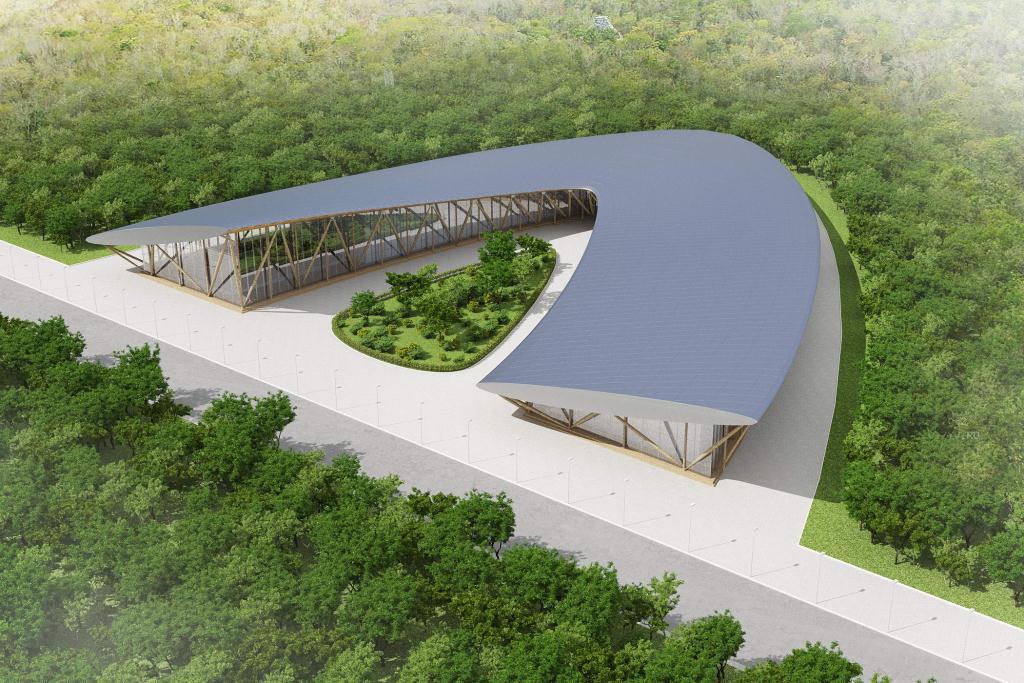

We had the task to build a conventional layout of the sports center, equipped with the most modern IT-technologies. The result we showed at the exhibition "SPORT".
')
Here is what we gathered in one complex:
- LED navigation floor gym.
- Wristband data collection (with RFID tags).
- Instructions for simulators in augmented reality.
- Content Management.
- Automatic system of fixing points in tournaments.
- Various projection systems.
- Telemedicine system.
- Autonomous management of engineering systems.
- Security, video analytics and pro-fire measures.
- Situational center for managers: visual economic and engineering indicators, forecast estimates for decision-making, etc.
Come, show.
Entrance:

View from above:
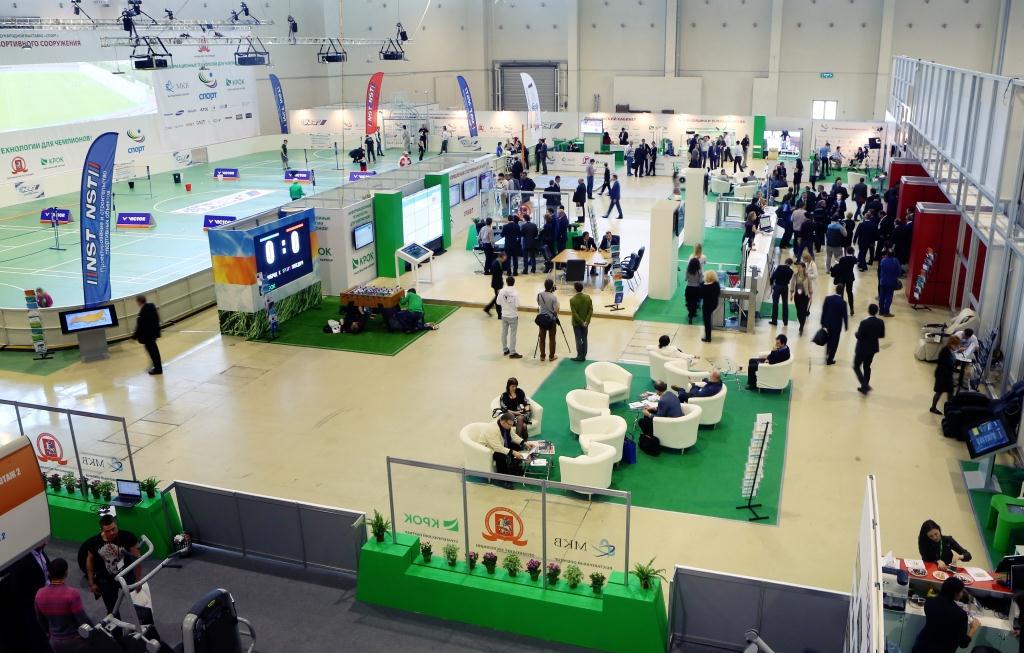
Access
It all starts with access control systems on the site. These are the turnstiles equipped with RFID readers stood at the entrance to our sports center. In principle, this could also be the 3D facial recognition technology that we already loved (we have a very cool PAC for recognition, which distinguishes even twins with earflaps and dark glasses), but RFID bracelets in the sports center can solve additional problems.

For example, in the bracelet may be pulse sensors. It is convenient to search for the bracelet inside the sports complex to assess user flows and equipment load (which in the future means more uniform wear of simulators). An RFID chip can be embedded in the bracelet, opening “its own” smart locker. According to it, you can register in the information kiosk system and record the training program or pay for purchases at the fitness bar, and not carry cash with which it is very inconvenient to work.
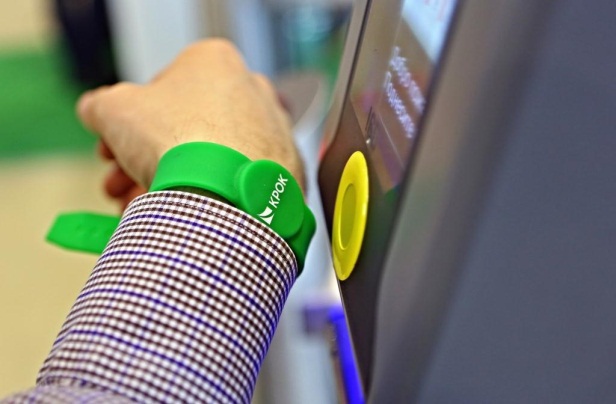
Content Management
In simulators it was important not only what they are cool and functional, we strengthened this functionality with the ability to connect to the content management system. From the top of the simulator, you can see the touch panel on which you can run a movie, a progress bar for lost calories, or a pulse monitor from the same bracelet. Or all at once. True, I suspect that viewing the series on the simulator will be the most useful function:
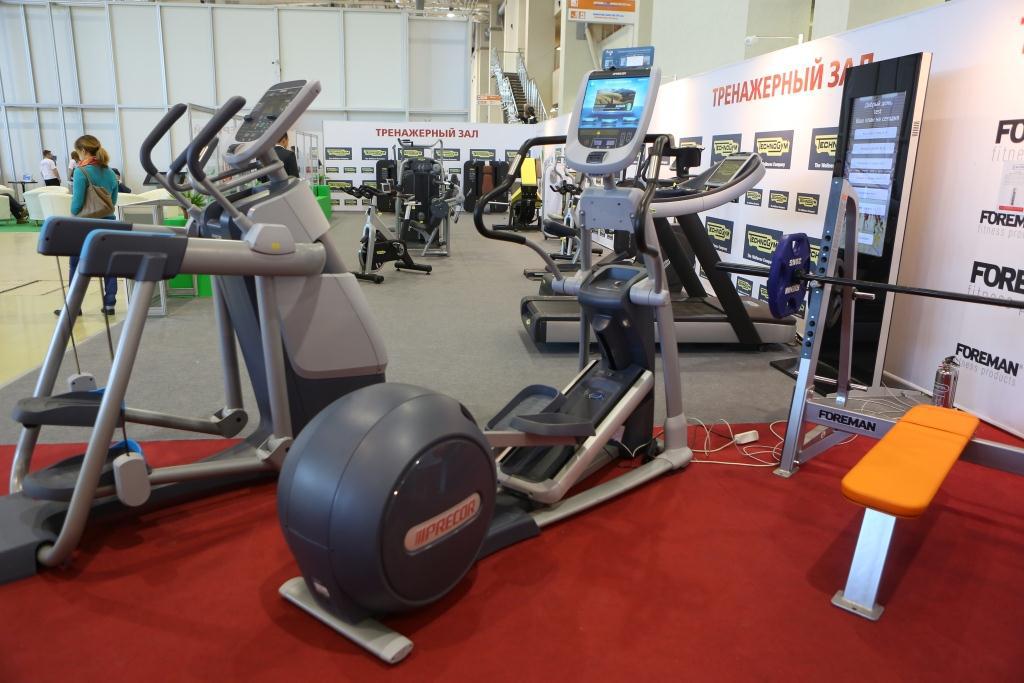
Instructions
The next thing in our sports center layout is augmented reality. Point the camera of a tablet or smartphone on a special label that can be applied to anything (for example, on the simulator itself or next to it), it is recognized by the mobile application of augmented reality. It loads the prepared content. It was like this: a person appeared on the screen, approached the simulator, showed how and what to do and in what sequence, with a separate color in the process of rendering 3D content you could see which muscle groups were involved in this exercise.

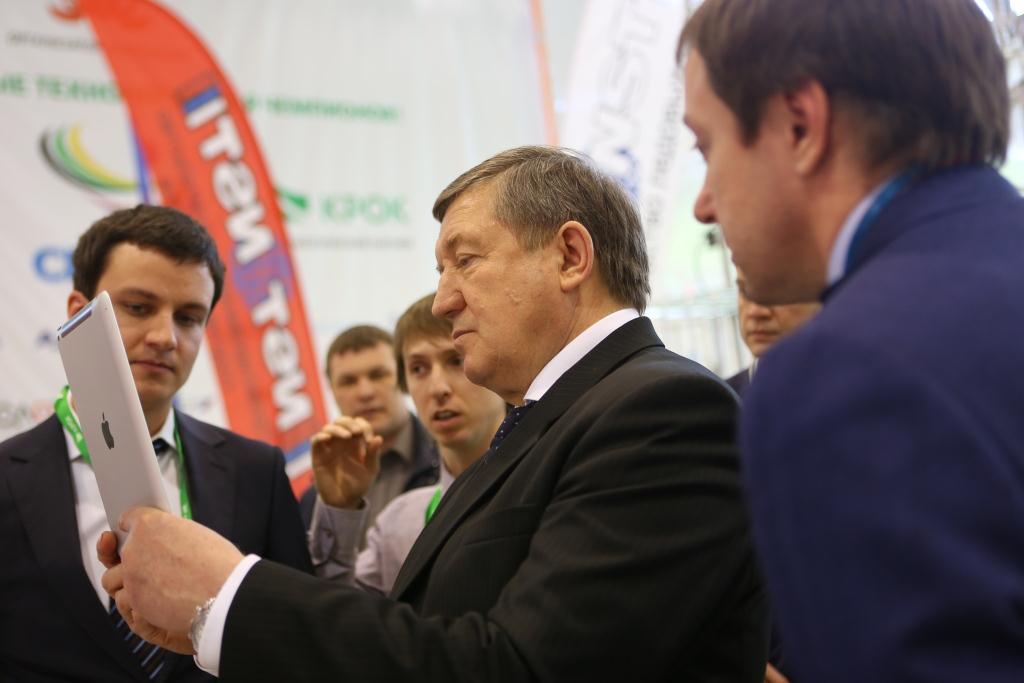
LED floor
Here we show to the Minister of Sports a floor with adjustable marking . LED marking on it allows you to quickly "redraw" the situation depending on the type of competition. In Europe, they are already used. The coating of a special translucent, lightweight impact-resistant material has also passed the necessary certification in Europe.
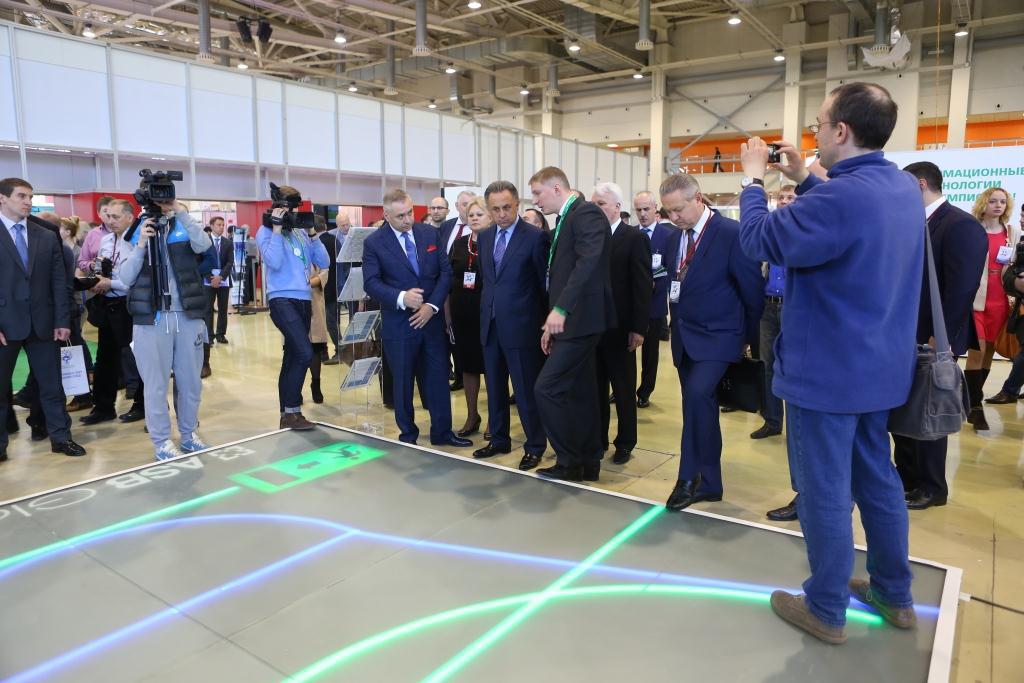
Tournament table
This one would be no different from those that are now in many institutions, if it were not for the LED screen nearby and the system for fixing goals scored. The same automated complexes can be bolted to any analog tables - even table tennis, although chess (although there recognition will be more difficult).

Informing and entertaining
There were a lot of interactive tables, shop windows, kiosks and screens . They can be used to obtain data on the workload of the halls, the formation of individual programs, navigation through the sports complex, and so on.
Below is just an interactive showcase. The screen (and, in fact, this glass with a transparent interactive film) displays the content (photos, videos, whatever) corresponding to the contents in the storefront. For example, in any sports center there is a “museum” of cups, medals, etc. You can put them in such a shop window, and on the screen show the history of each of them. At the same time, the content can be manually moved around the storefront, zoom in and out, delete and load a new one, in general, “play” with it in different ways.

And here we have an interactive table with children's games. Accordingly, most of the games about “slam the color spot” and so on - develop attentiveness, coordination, reaction and other abilities. A small children's corner, as it seemed to us, is often not enough in sports complexes.

Moving to the sports field. Here behind the player is a large projection screen measuring 4 by 20 meters. The picture is displayed on it from the system of projectors, while the image is smoothly stitched. There are two stitching techniques: pixel-by-pixel and overlay. When applying the same zone on the border of the frame, two projectors can show at once: this allows you to maintain brightness and avoid all kinds of seams.

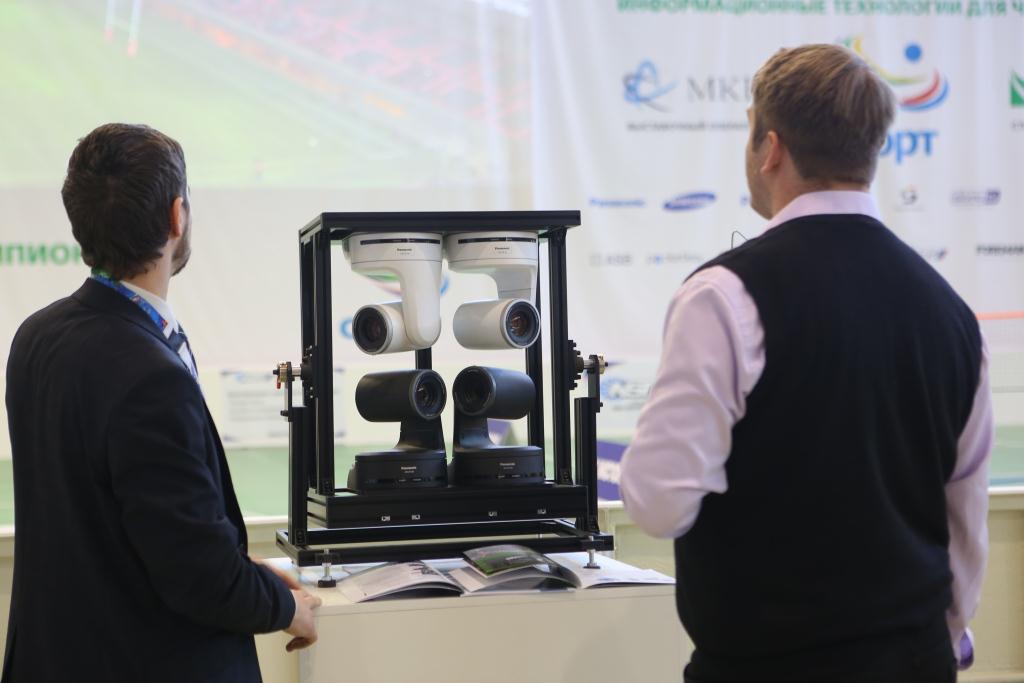
Camera system (part of the projection system)
Telemedicine
Medical unit . In this particular case, doctors conduct a remote consultation. This is the same telemedicine, which is now so much talk. You can go to the office of the sports center (and in fact also clinics, sanatorium, school, student or factory first-aid post, you can even put it at home) in Izhevsk, use the automatic ECG complex and enable video communication with the doctor. “My heart is bothering me with something, here is my ECG, doctor” - “Let's measure the pressure” - and send the data from another automatic meter right there, - “So, so, do you smoke?” - well, then on the situation . Such a telemedicine complex can produce up to 150 different measurements and analyzes. Most of them the patient can spend on their own.
Workplace doctor:
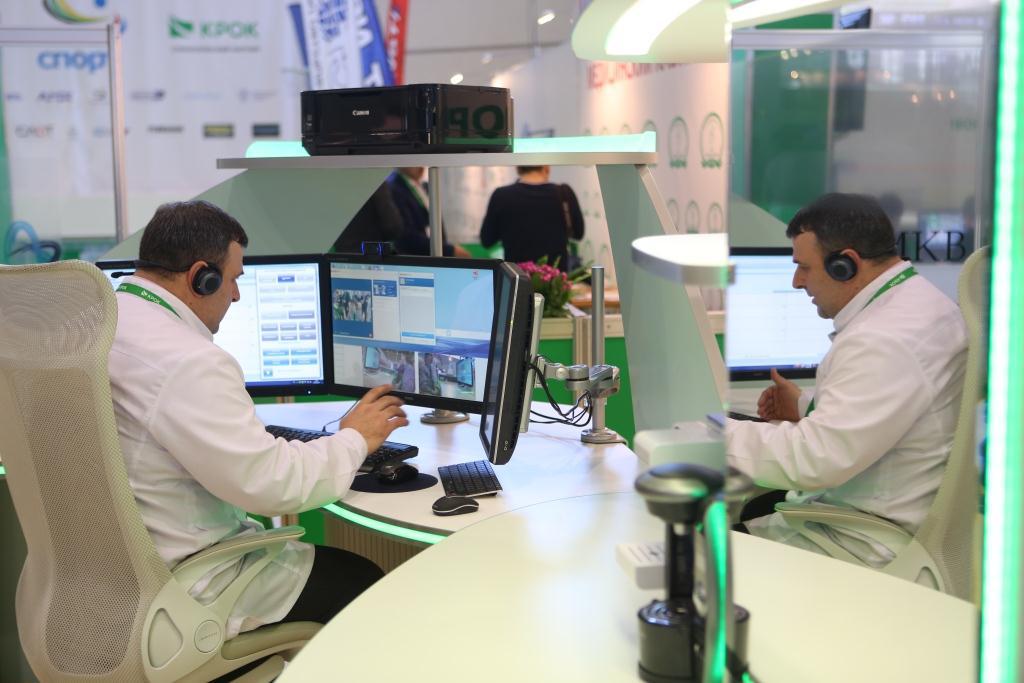
Patient's workplace:

It can be completed with emergency first-aid kit, the means of which can be used as directed by the doctor. In the case of the sports medical center here you can download the data from the bracelet. Then it will actually treadmill test.
Situation Center
Here is another important area. A kind of situational center for the leader or supervisor of a sports development program. Here is an interactive table and a video wall with elements of business intelligence on managing a network of sports complexes. The program features objects on a map, where the user is offered information in several analytical sections: the federal network, the regional level, a separate object. The interface of business intelligence systems allows you to quickly see the status of the branch network in the regions and at individual sites that are lagging behind the planned indicators, and then examine each of them in detail. To demonstrate the work of such analytics for managers of sports complexes and networks, we have prepared various network development scenarios based on historical data and general trends in the country and the market. It helps to plan activities one step further, controlling costs and effectively developing the entire network. But in general, with the help of such a management tool, you can work with almost any unstructured data, present them in the necessary analytical sections — view the state of the complexes, the results of their “business” activities, the network, the market as a whole ..
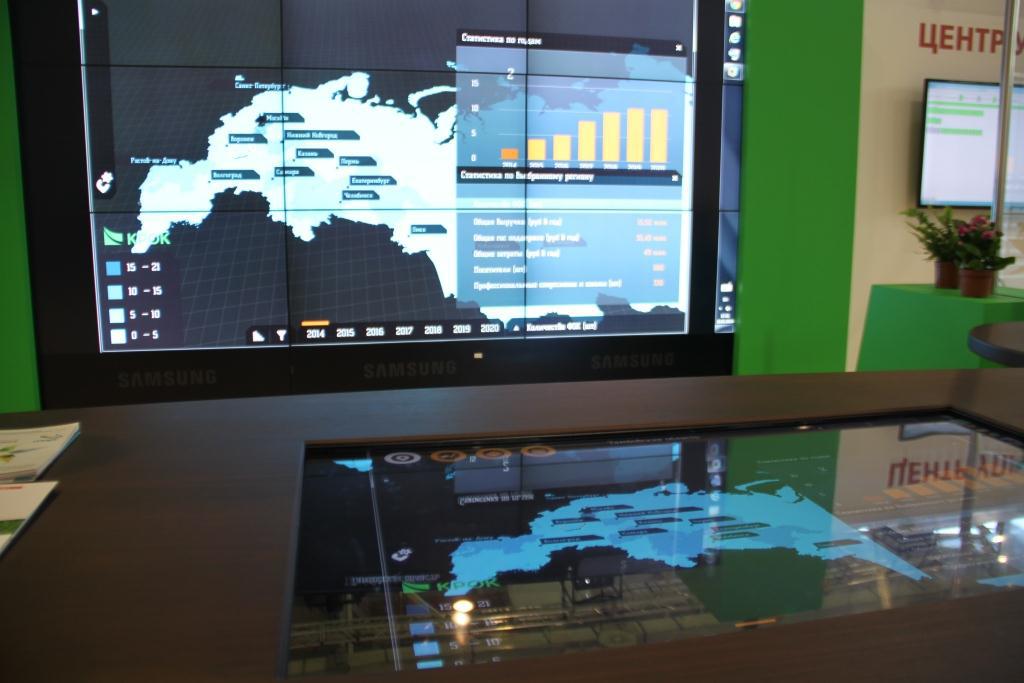
Of course, solutions are integrated with object infrastructure management systems. This allows you to consolidate data on the use of space, efficiency of enterprises, attendance, etc. If suddenly exercise bikes and punching bags are unusually popular in the region - or if their share is gradually increasing throughout the country - the next sports complex under construction will receive a project taking this fact into account. We have put in a set of forecasts for Russia and the dynamics of the population for 2016 year.
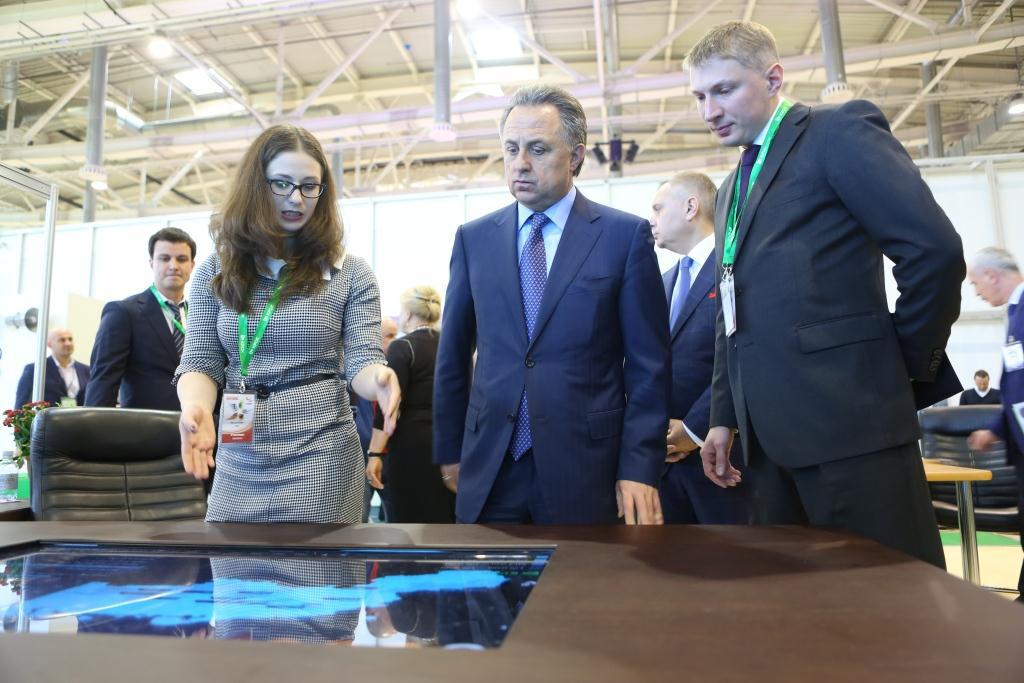
Such a “situational center for the manager” worked through our “cloud”. But, of course, it can work with local servers, and with Amazon, for example.
Whistles
Here in the situational center we demonstrated the work of the internal information network , which was built on the basis of Jive. It may consist of user accounts (personal accounts) and event calendars. Here you can synchronize information on height and weight, pressure, pulse, statistics of visits, on which simulators you worked, what you did, on what day for each athlete / visitor to the gym. But the main thing is the social part, with the help of which one can reveal part of the data, set goals and collect likes, support of friends. In this case, you can track the target automatically, and catch, for example, that a person dropped 4 kg - and give him a medal for it.
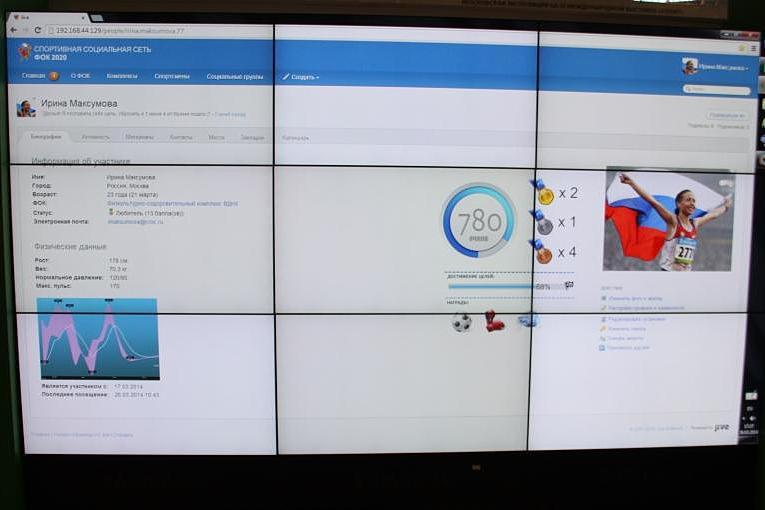
Engineering
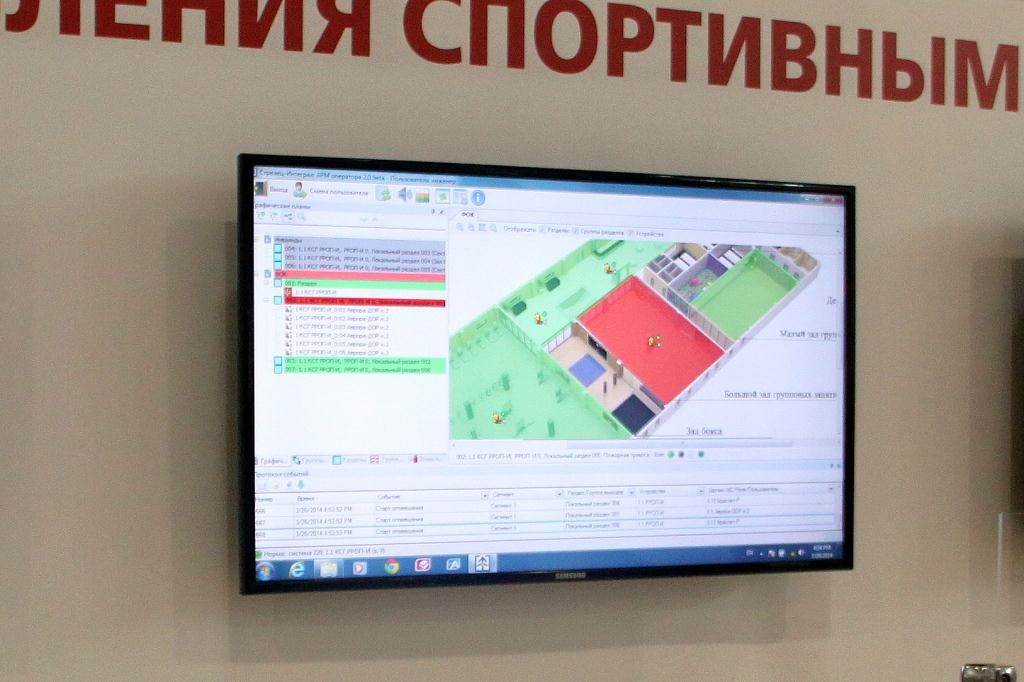

One of the most difficult parts of the sport center is the engineering functionality . We have a lot of experience in connecting and integrating engineering systems, so we can be said to have eaten a dog on engineering monitoring. For example, in two of its offices and three data centers. Of the recent, the Sochi air terminal and 13 buildings for the Olympic families and the International Paralympic Committee were equipped with engineering systems.
In our model of the sports complex, it was shown how several levels of engineering systems can be monitored from one console. On the “smart” layer there are floor plans with an assessment of the effectiveness of the use of equipment and space in general, the state of the infrastructure, the degree of depreciation.
A level below - hardware devices for automation of the complex. There are automatic lighting systems according to the presence of people, ventilation depending on the load of the hall and air conditioning. Plus, the usual engineering monitoring in a graphical interface and numerical indicators. You can also use intelligent systems to manage the meeting rooms and conference rooms located in the building. In accordance with the schedule of events, they can automatically change the settings for lighting, air conditioners and other systems, which increases the efficiency of the use of technology and reduces operating costs. All this in a complex can save up to 20% of energy resources and greatly reduces maintenance costs.
For people recovering from a severe injury or who have become disabled, the opportunity to call for help is relevant. Therefore, they have a special version of the individual bracelet with a large and easily pressed SOS button. When you click on the medical unit, an alarm signal is sent, plus a floor plan is immediately displayed with the location of the bracelet, and if it is in the area of the cameras, you can immediately display the picture on the screen.
Evacuation . At a large sports facility, a person will know a maximum of two entrances. Most often - the one that he uses usually. We can use our wireless system together with the heuristic module to build the optimal evacuation route. And output it to all devices that allow you to do this. Including not only the screens of the building, but even individual bracelets (they can lead by voice). The route is constructed taking into account the prediction of the spread of fire (for example) and taking into account the user's biometric readings - his height, speed, restrictions (the route for a wheelchair user will be different from the master of sports in long jumps).
If it was not possible to evacuate, bracelets can be used to search for people. For example, when firefighters enter a room, a security specialist can display a plan in it showing the position of each bracelet.
Security
CCTV . One of the main problems of video surveillance at such large sites is very healthy data sets. As a rule, they grind in a couple of weeks, if not days. But now there are intelligent systems that can highlight keyframes (for example, the most distinguishable face in front of the camera on the door) and store them only along with the date, time, and any other specified data. The result is an archive not with video, but with enough data to analyze the situation that can be stored for years.
Inside there is a high-level environment and a language that allows you to make a reaction according to various criteria. Suppose if at a certain time a person enters a certain door, respectively, we remove it, identify it, put a photo with this person in a specific network folder, pre-registering its route. In addition, you can build on the size of the object and remove the extra background - including ever-moving leaves.
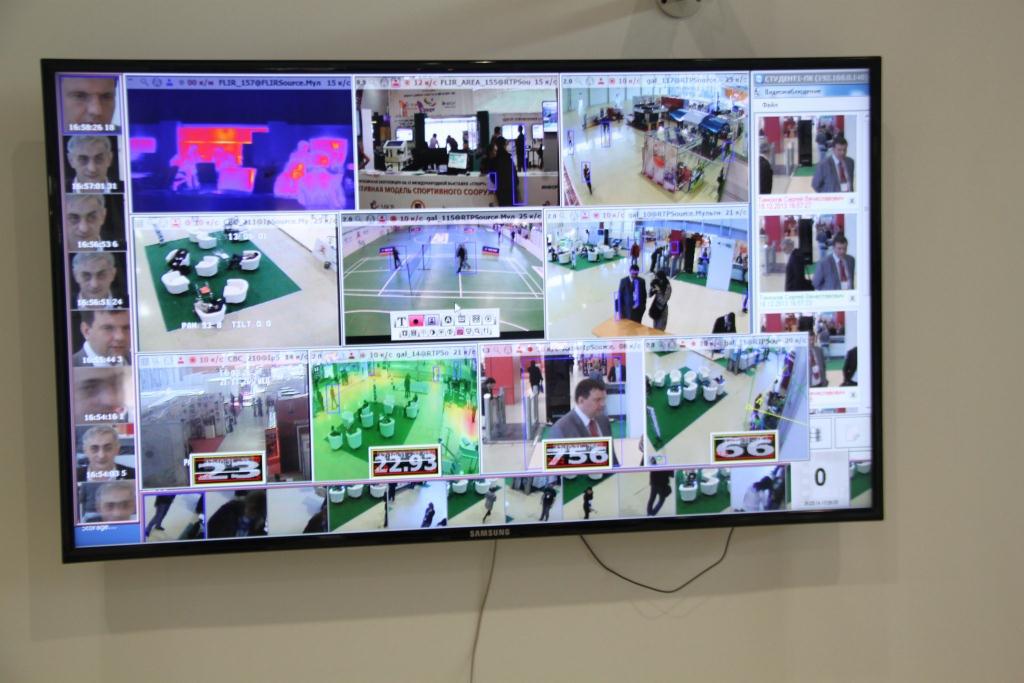
In case of emergency, there are means for estimating the number of people in the room, for example, by the number of mobile phones, and if necessary, you can automatically send alarm SMS to their numbers. In general, the sensors can be used absolutely any - gas analyzers, catching almost separate molecules (we use such for fire extinguishing systems in our own data center of increased responsibility - even if you suddenly have thin wiring in the far rack, we will immediately be alerted) and so on.
Instead of a video camera, you can use a thermal imager , if you put one, for example, at the entrance to a kindergarten, then it’s not at all problematic to screen out sick children with fever from healthy ones, or take drug addicts from flights, they are usually warmer than a normal person.
"We love answering anonymous questions, Ivan . " Yes, you can recognize each person at the facility with a collision probability of 1 to 2.5 million. That is, it is almost like a DNA test - the same error. And this is definitely better than a card and a chip - the face and the retina are always with you.
Previously, we worked with the definition of the face and distinguished even the twins with earflaps and glasses. Now we have a PAK that allows us to remove retinal data “on the go” from 3-4 meters.
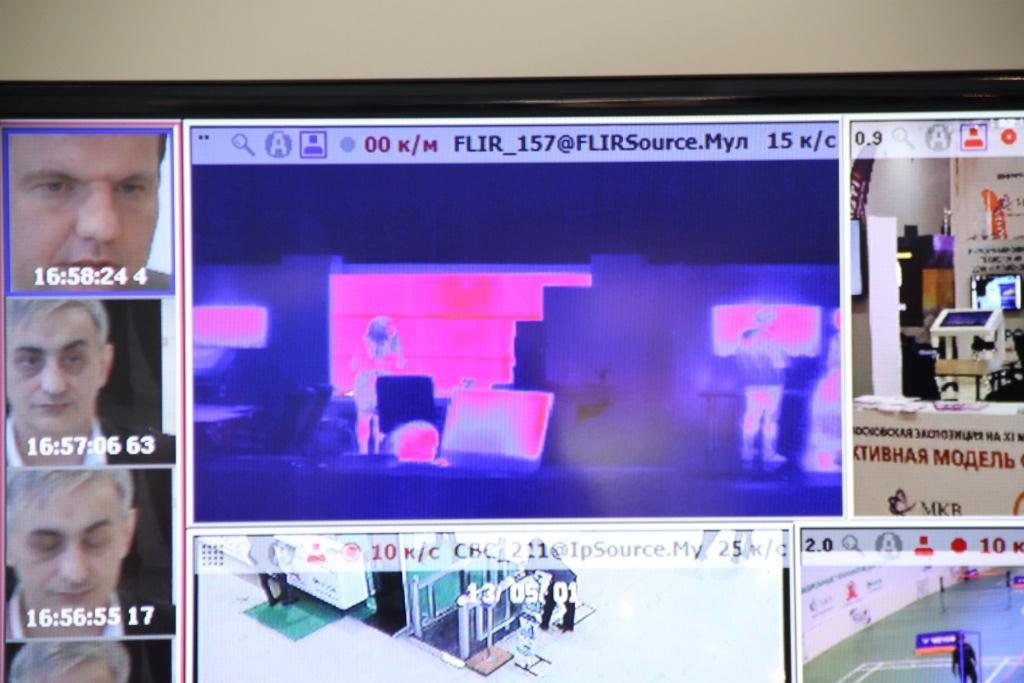
Video Replays
And this is a zone of video judging. Such complexes are used by the KHL for judicial decisions on violations or the exact definition of difficult situations with a goal.
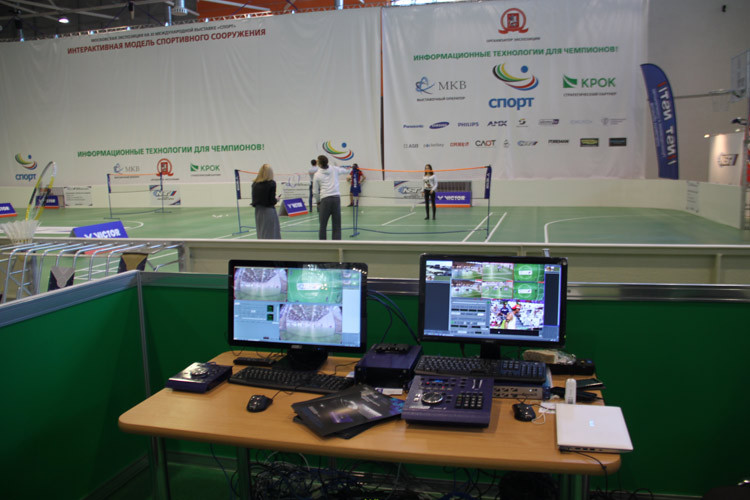
Summary
Our "exhibit" took 2000 square meters. And a lot of this may be available soon in more than 1000 objects in Russia within the Federal Program of Federal Sports of the Ministry of Sports, of which 400 have already been built.
As a system integrator, we have a comprehensive approach to project implementation and can do everything - from architectural design and construction of the building itself, to equipping it with modern IT solutions. In addition, we conduct tests of the most useful things, test hardware components for wear, bundle everything into one system, and so on. From the latter, we designed the entire engineer (40 subsystems) for a large stadium. If interested - I will tell in more detail.
What about in the future?
As I have already said, much of what we used in our layout of the sports complex is already used somewhere. However, not everyone in Russia, and nowhere else in the complex. Therefore, to some extent this is the future. But we didn’t stop at that, and together with our partner, the Arch group architectural bureau, we discussed how the future sports complexes could look (from the position of ergonomics, design, convenience, etc.). Here's what happened:


And this is a variant of the internal layout:
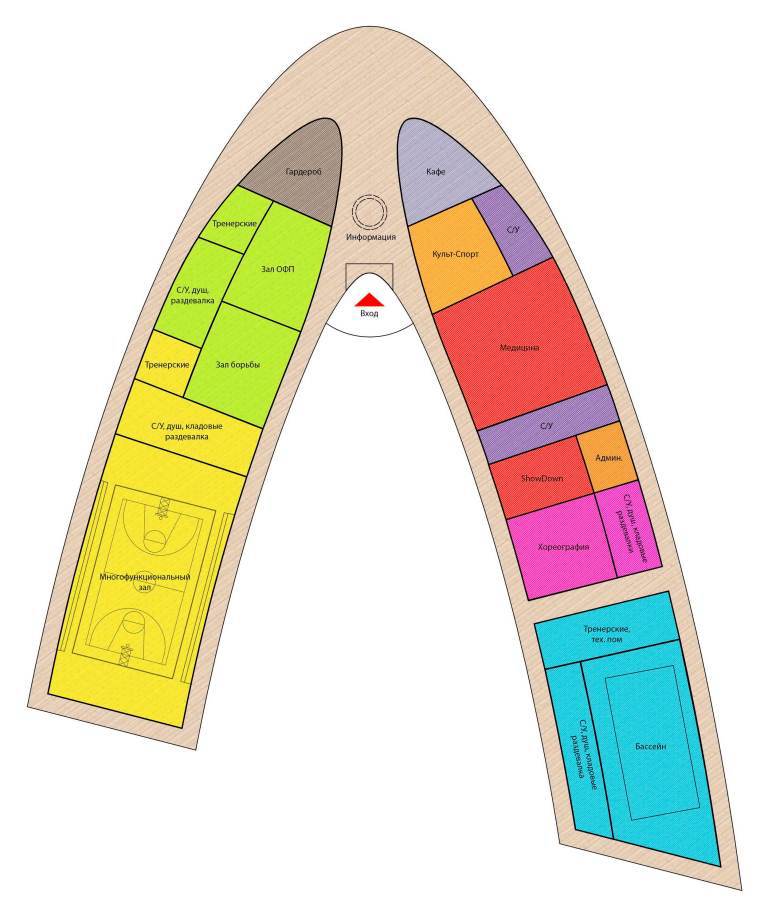
At the end of the tour. I would welcome comments. If you have questions, write in a personal or email - rmorozov@croc.ru.
Source: https://habr.com/ru/post/218893/
All Articles